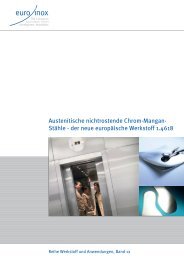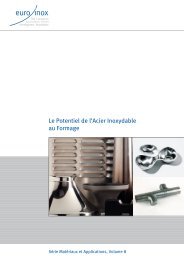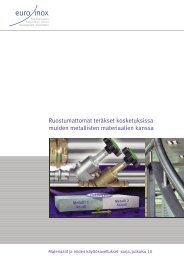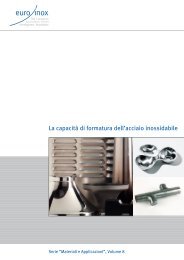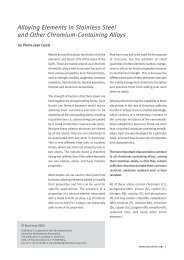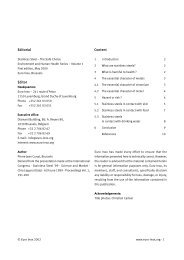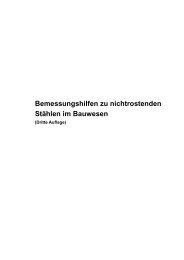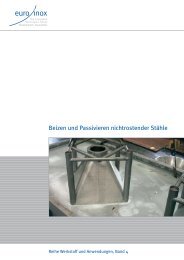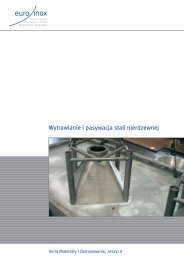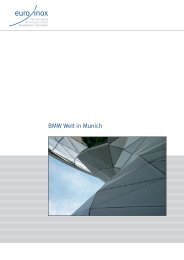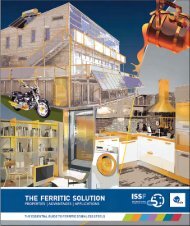Innovative Stainless Steel Applications in transport ... - Euro Inox
Innovative Stainless Steel Applications in transport ... - Euro Inox
Innovative Stainless Steel Applications in transport ... - Euro Inox
You also want an ePaper? Increase the reach of your titles
YUMPU automatically turns print PDFs into web optimized ePapers that Google loves.
1. Introduction: sta<strong>in</strong>less steels <strong>in</strong> <strong>transport</strong><br />
vehicles<br />
The use of sta<strong>in</strong>less steel <strong>in</strong> ground <strong>transport</strong> is by no means new: its track record goes<br />
back nearly three quarters of a century. In the case of railway coaches, it was durability<br />
and ease-of-ma<strong>in</strong>tenance considerations, especially, that tipped the balance towards<br />
sta<strong>in</strong>less steel. With design lives of often more than 40 years, roll<strong>in</strong>g stock is an<br />
application for which it is worthwhile consider<strong>in</strong>g <strong>in</strong>tr<strong>in</strong>sically corrosion-resistant<br />
materials.<br />
Buses and coaches have a service life of 20 years and more. For coat<strong>in</strong>gs on less<br />
corrosion-resistant materials, such a long time span is difficult to survive without major<br />
ma<strong>in</strong>tenance and repair. Condensation and the <strong>in</strong>fluence of de-ic<strong>in</strong>g salt can make<br />
corrosion protection a challenge. For this reason, sta<strong>in</strong>less steel has also been used<br />
successfully not only for the sk<strong>in</strong> but also the structure of buses and coaches.<br />
Over the years, rail and bus technology has developed – and so has sta<strong>in</strong>less steel. The<br />
ref<strong>in</strong>ement of metallurgical processes has further improved the uniformity and<br />
corrosion-resistance of proven chromium-nickel sta<strong>in</strong>less steels. The range of<br />
mechanical treatments to further enhance their mechanical properties has been<br />
extended. New grades have been developed, <strong>in</strong>clud<strong>in</strong>g chromium-manganese types,<br />
which comb<strong>in</strong>e cost reduction with high mechanical strength. Ferritic sta<strong>in</strong>less steels<br />
have given rail and bus manufacturers new and particularly cost-effective options,<br />
especially for the outer sk<strong>in</strong> of vehicles when customers require pa<strong>in</strong>t<strong>in</strong>g for reasons of<br />
corporate design. It is the purpose of the present publication to give a research-based<br />
overview of the new potential that has emerged over the last few years.<br />
1.1 Rail applications history<br />
Invented <strong>in</strong> the early 20 th century, sta<strong>in</strong>less steels were soon applied to the rail <strong>in</strong>dustry.<br />
The 1930’s brought widespread use of sta<strong>in</strong>less steel for rail coach bodies. Weight<br />
reduction became a priority and laid the ground for levels of speed and comfort that had<br />
not been experienced before. Especially <strong>in</strong> North America, sta<strong>in</strong>less steel became the<br />
preferred material for rail coaches.<br />
Although sta<strong>in</strong>less steel is neither the lightest of materials nor the least expensive, both<br />
manufacturers and operators soon discovered that its outstand<strong>in</strong>g long-term corrosion<br />
resistance provided ma<strong>in</strong>tenance and cost advantages. The fact that pa<strong>in</strong>t<strong>in</strong>g became<br />
redundant made sta<strong>in</strong>less steel even more attractive. However, it was also a market<strong>in</strong>g<br />
issue. Long-distance rail travel was positioned as a modern, technologically advanced<br />
option for the demand<strong>in</strong>g customer and sta<strong>in</strong>less steel was an icon for this idea.<br />
7



